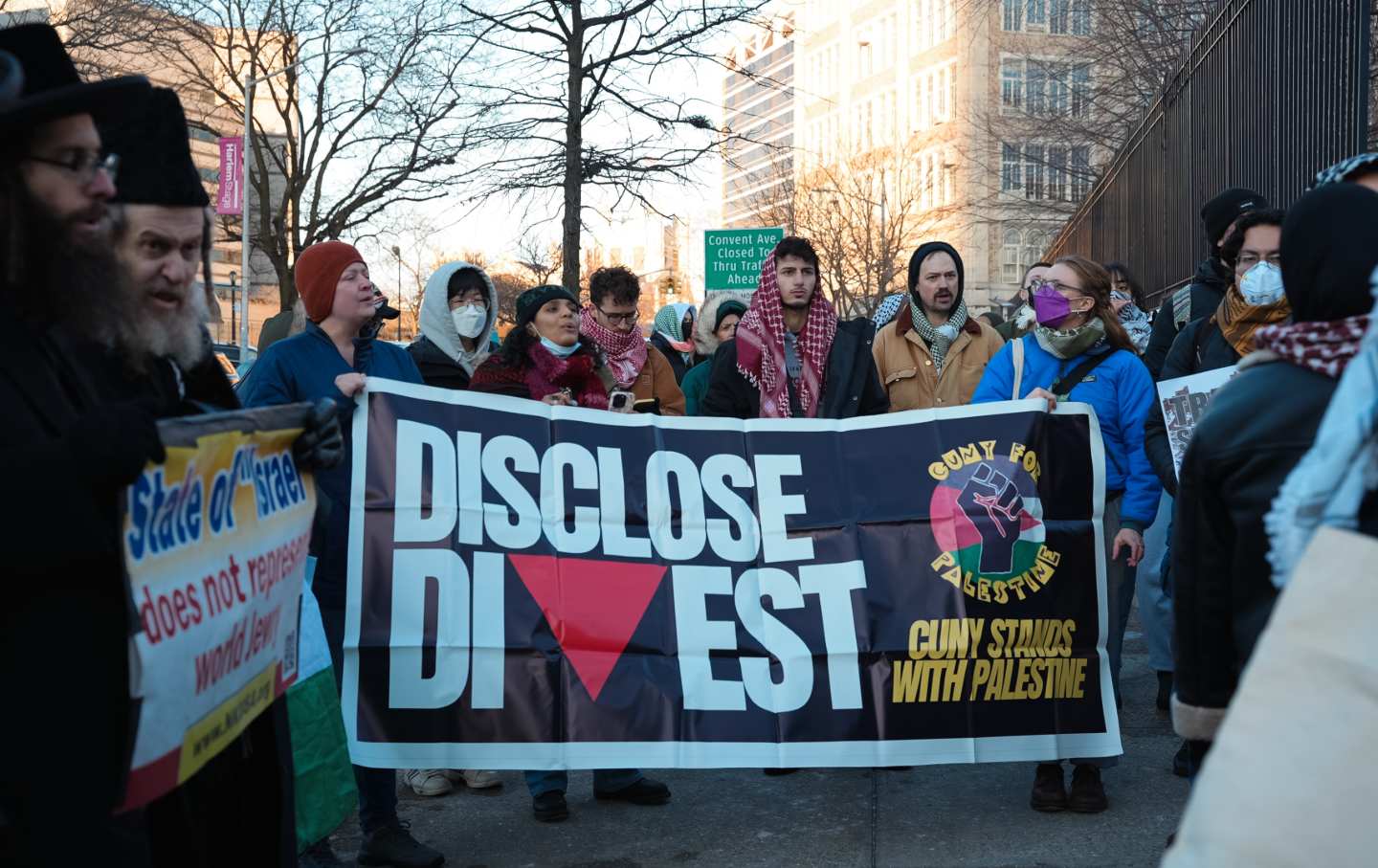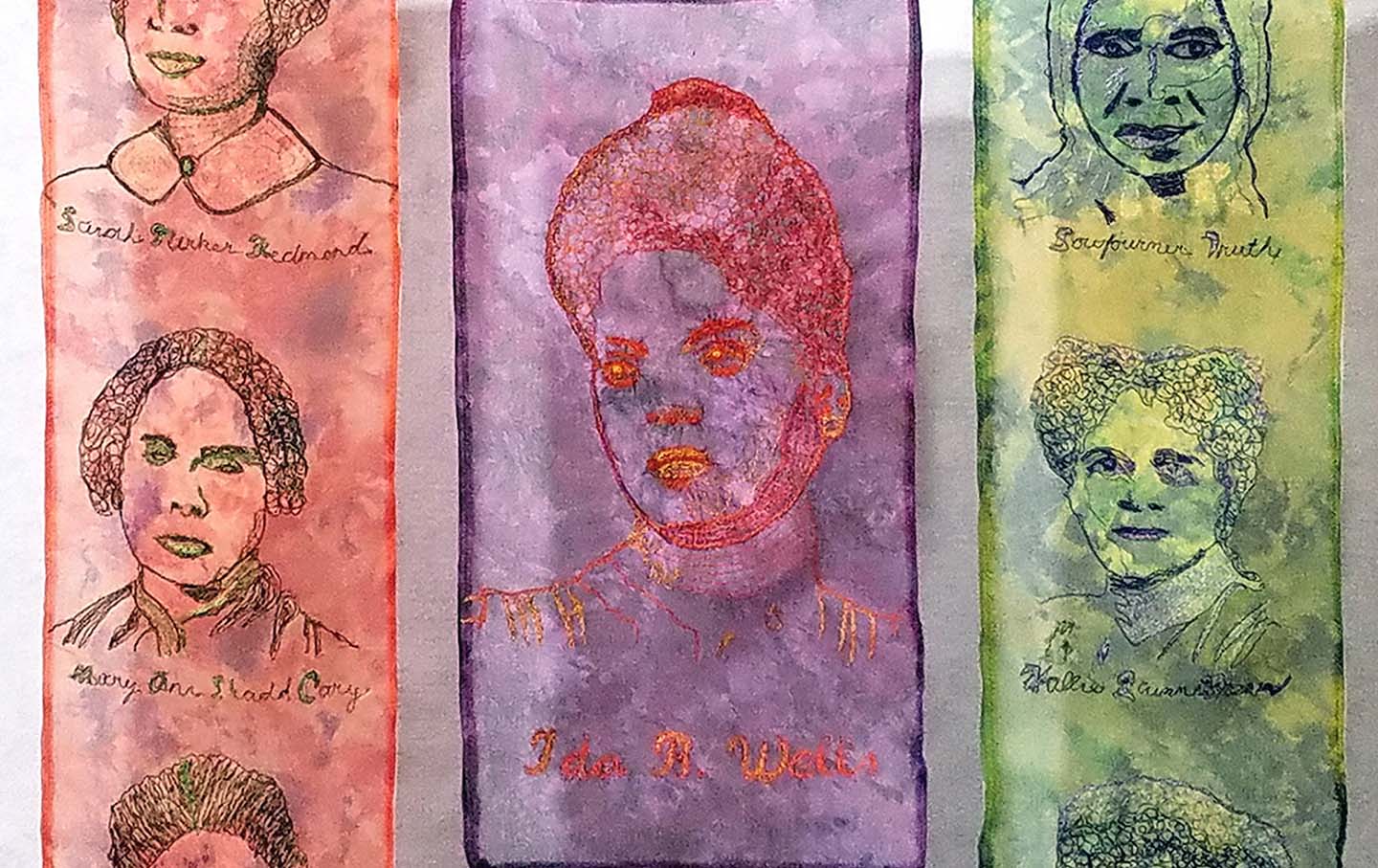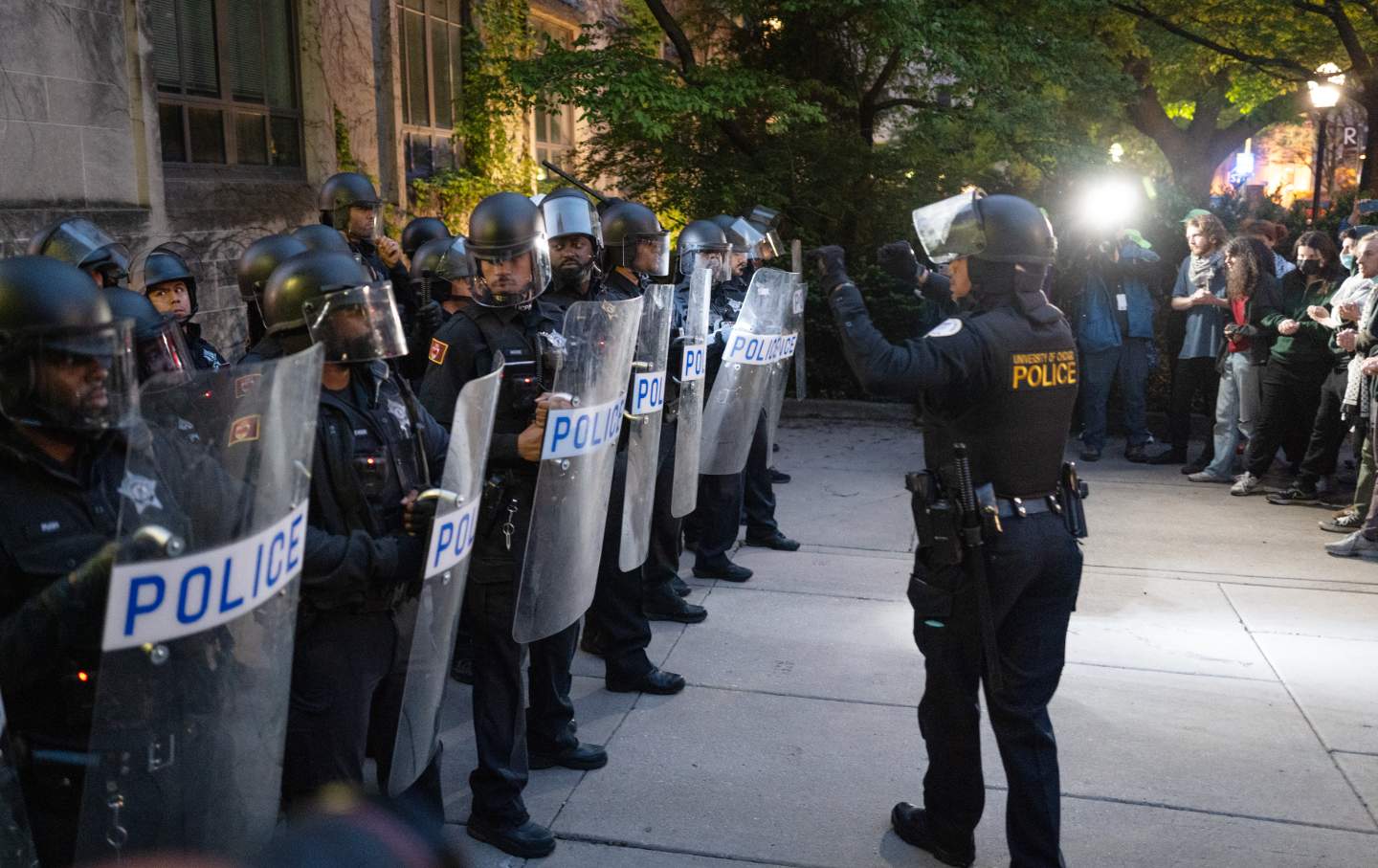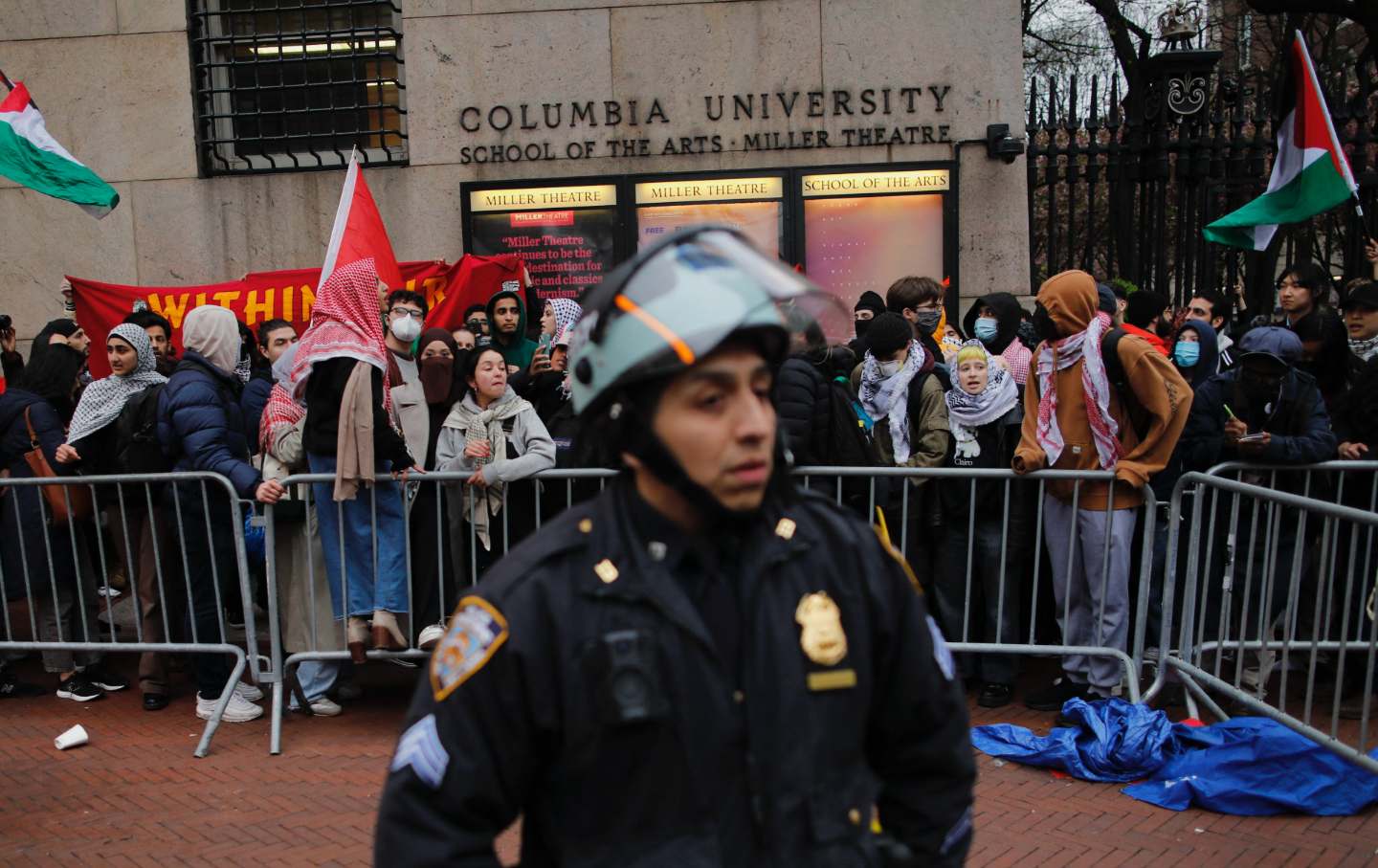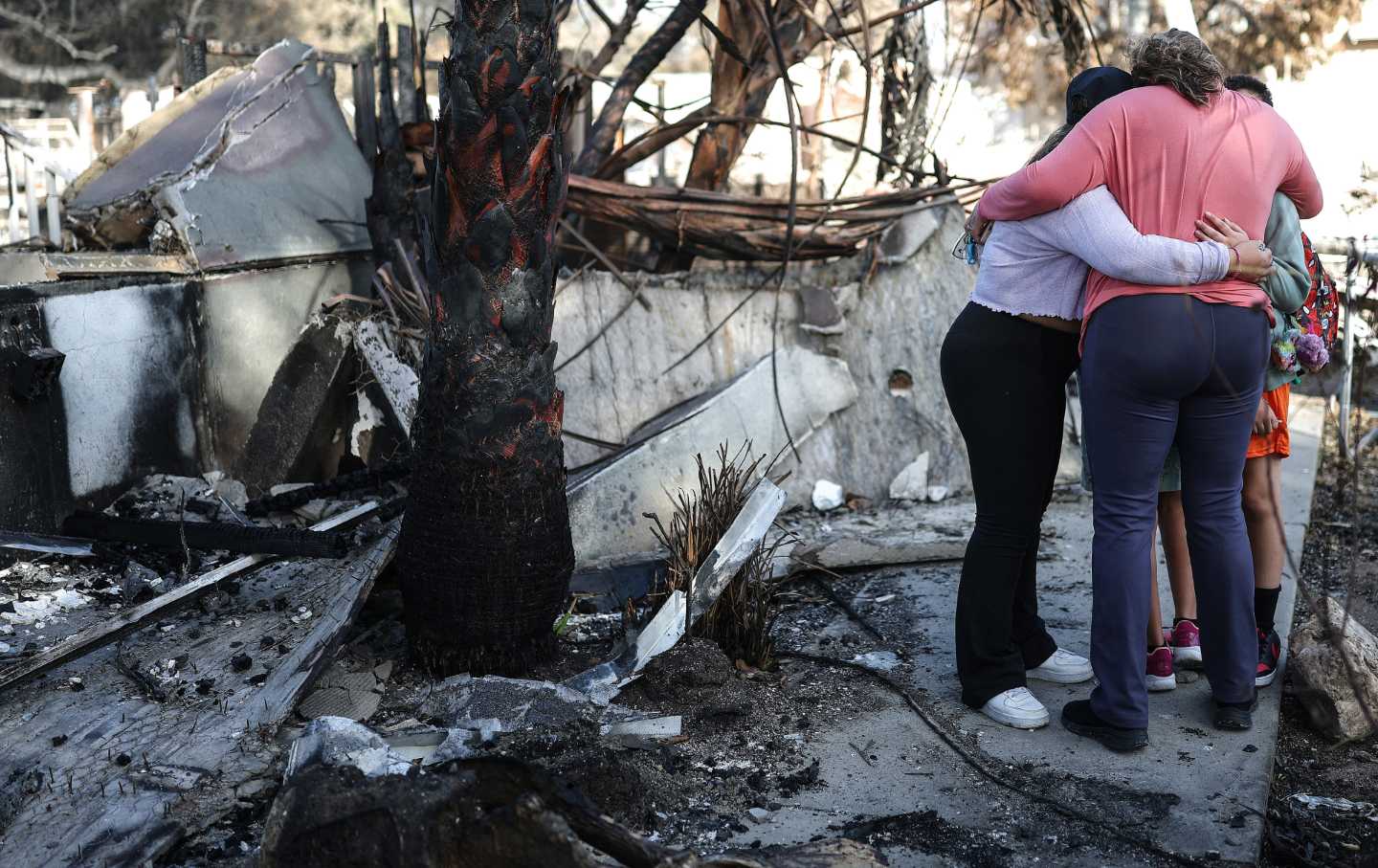How Amazon Is Taking Its Union-Busting to New Heights
Organizers describe fear tactics, amped-up security, and daily town halls as workers vote on whether to unionize.
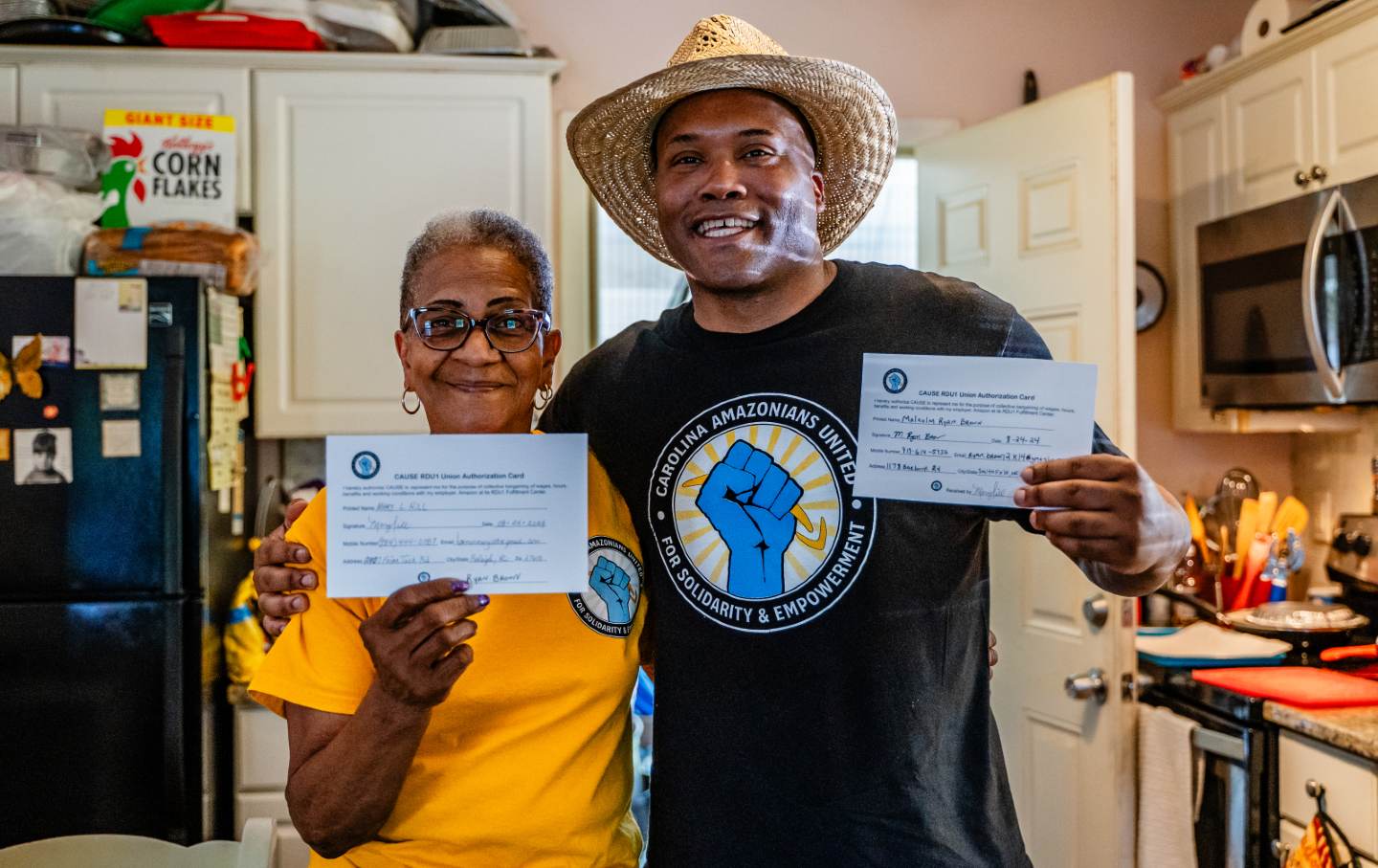
The Rev. Ryan Brown and Mary “Ma Mary” Hill show their signed union cards on September 2, 2024.
(Courtesy of CAUSE)
Amazon’s RDU1 fulfillment center is a nearly windowless 2 million-square-foot box squatting along Jones Sausage Road outside Raleigh, North Carolina. In early February, a new structure cropped up on its property line—an 8×8 bright yellow tent cutting a striking silhouette against the gray warehouse. Affixed to the tent poles are signs with big block letters (“Vote union yes”) and pale blue flags emblazoned with a fist gripping an instantly identifiable icon—the orange Amazon “smile” arrow, inverted as a frown.
As workers stream out of the warehouse at the end of their shift, many stop by the tent to grab a sub or a shirt, or to ask a question. For two weeks, this is the headquarters for Carolina Amazonians United for Solidarity and Empowerment, or CAUSE, the union that filed for an NLRB election in December. Between February 10 and 15, RDU1 workers are voting on whether to become the second unionized Amazon warehouse in the United States.
Leading up to the election, Amazon has deployed its now-familiar union-busting arsenal to quash the worker-led movement at the nearly 5,000-person warehouse. Managers and HR professionals from across the country have flown in to patrol the shop floor and repeat anti-union talking points in small group meetings and warehouse-wide town halls. The company erected metal barricades between CAUSE’s tent and the warehouse. An anti-union video plays on an endless loop in the break room. “This place is starting to turn into a labor camp,” said Italo Medelius, an RDU1 worker and organizer with CAUSE.
The movement to unionize Amazon’s Garner warehouse has been three years in the making. CAUSE’s president, the Rev. Ryan Brown, started organizing with his coworkers in January 2022 because he felt the company was not adequately protecting workers from Covid-19. Medelius learned about the union when Brown approached him for help translating a petition into Spanish calling for fans inside the warehouse. “People were literally fainting from heat stroke during the summers,” said Medelius. CAUSE won that demand, proving to RDU1 workers that collective organizing can deliver results. (Amazon denies that there have been any instances of work-related heat stroke at RDU1. In 2023 The News & Observer reported that two RDU1 workers were hospitalized after feeling faint on the job, which they attributed partly to the temperature in the warehouse.)
In January 2024, CAUSE decided to begin collecting union authorization cards. Organizers developed a strategic roadmap to secure the National Labor Relations Board–required 30 percent of signatures to trigger a union election, including fundraising and forming organizing committees for the day and night shifts, and for Spanish-speaking workers. By December, CAUSE had collected cards from 42 percent of workers.
CAUSE is demanding $30 an hour for associates, paid sick leave, and increasing break times from 30 minutes to an hour. Currently, starting pay at RDU1 is $18.50 an hour—and that’s after they raised wages for fulfillment and transportation by $1.50 in September. “If they paid a living wage, people wouldn’t have to be sleeping in their car to go to their second job,” said Mary Dulberg, an RDU1 worker who has been involved with CAUSE since its founding.
Workers are also asking for dignity at work, and respect for workers of all nationalities and ethnicities. At a warehouse where Hispanic workers make up a large portion of the workforce, Medelius said he often has to accompany his coworkers to HR meetings to translate for them. “The organizing conversations that have been the most poignant have been with our Spanish speakers, with our Arabic speakers,” he said. “We need to have some sort of language justice in this warehouse.” CAUSE’s newsletter is published in English, Spanish, French, Arabic, and an audio version. Medelius noted that Amazon has made sure to translate its union-busting materials into Spanish. (Eileen Hards, a spokesperson for Amazon, said, “At all of our facilities, we work to foster a culture of inclusion with employees. We welcome people from many backgrounds, experiences and prior careers to join us.”)
Popular
“swipe left below to view more authors”Swipe →In the months leading up to the election, Amazon has installed new security equipment and implemented policies that workers say make them feel surveilled. In December 2024, during CAUSE’s card collecting campaign, Amazon began requiring workers to show their employee badges to enter the parking lot. Organizers also say the company added new security outposts to all of the building entrances. “They’re trying to instill fear and almost militarize the place,” said Medelius.”
Hards, the Amazon spokesperson, said, “The safety of our team continues to be our top priority. Over the past few weeks, we’ve had several incidents where individuals have trespassed and refused to leave our property, which is why we’ve added additional security measures to the site.” In December, Garner police arrested two community members and a former Amazon worker who were distributing food and helping to collect union cards outside the warehouse. On the eve of the election, police arrested an organizer from Amazon’s Staten Island warehouse who traveled to help with the campaign.
Amazon workers are already subject to surveillance by algorithmic management tactics that constantly track their pace of work. Teke Wiggin, a sociologist at Northwestern, studied the 2021 union election at an Amazon warehouse in Bessemer, Alabama, and found that Amazon deployed its management technology not just to discipline workers but also suppress collective organizing. Wiggin’s new paper, “Weaponizing the Workplace,” outlines how Amazon used digital displays at workstations and the employee app A to Z to flood workers with anti-union messages and heighten workers’ sense that they were being watched. He told me, “Amazon’s working conditions and capacities make a free and fair election impossible.”
Like at the Bessemer warehouse, where the union lost its election, Amazon has bombarded RDU1 workers with texts and messages on A to Z. A screenshot provided to me showed a notification with a red “alert” symbol reading, “Something to lose? A union can trade away things you value, like paid-for training and education, shift choice, or your Day 1 health coverage, for priorities they care more about—like dues deducted directly from your paycheck.”
It’s impossible for workers to ignore anti-union messages sent through A to Z, because they need to use the app to get important information about their shifts and pay. “Amazon can force-feed them messaging in a way that employers haven’t been able to in the past,” said Wiggin.
At the Garner warehouse, where the majority of workers are Black or Hispanic, managers have used these fear tactics to stoke racial divisions, organizers say. “Amazon’s strategy right now is to divide and conquer,” said Medelius. “They have been putting out all of these lies and trying to create tensions between Black and brown communities.”
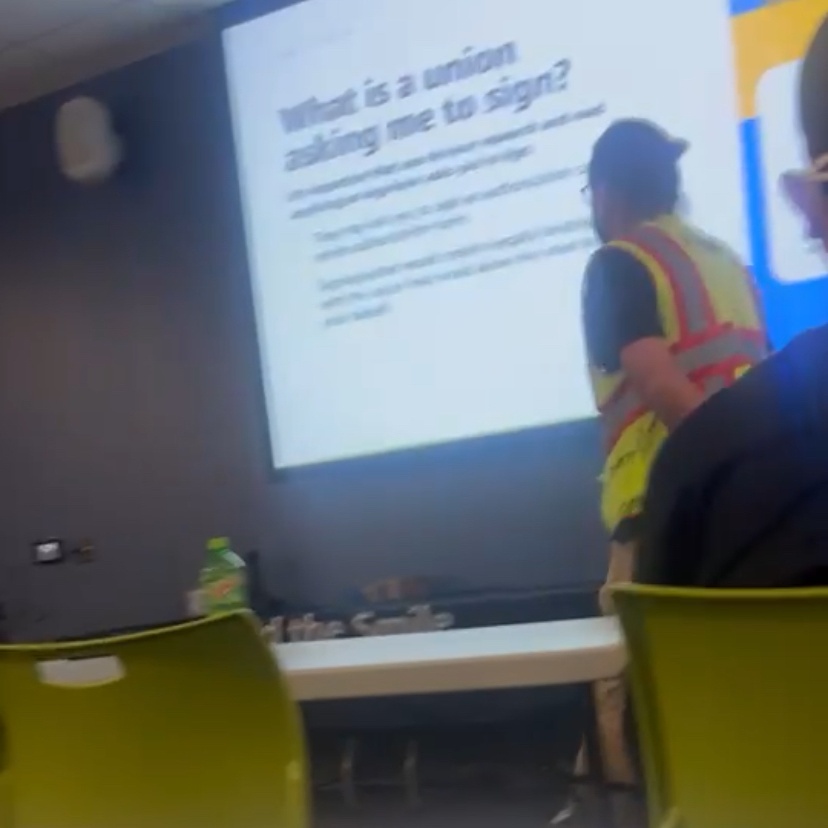
A video recording of an anti-union “town hall” meeting captured an operations manager telling workers, “I’ve heard CAUSE telling people that if you vote no, you can be deported.” CAUSE’s lawyer has reached out to Amazon’s counsel about this claim, which they see as potentially slanderous. “We know that Amazon is pulling incredibly illegal and really dirty tactics by using people’s fears against them,” said Medelius. “Especially when it comes to immigration, that is just a very, very low blow.” (According to Amazon, “Claims made by CAUSE of racism from managers is completely false and we have had no internal complaints filed from employees about this type of behavior.”)
RDU1 has hosted daily “town hall” meetings in the week leading up to the election, where managers deliver speeches and dance on stage, backed by a live DJ, to hype workers up to oppose the union. “It looks like MLM shit,” Dulberg told me.
In a video of one such assembly, managers delivered impassioned, occasionally personal pleas for workers to vote no. One Amazon operations director tearfully invoked the story of her young daughter’s struggle with leukemia to convince workers that CAUSE may not deliver on its promises. “You could lose the things that are most important to you and your family,” she said. “For me, it was benefits. Because that was the thing that kept my daughter alive 12 months longer than she probably should have been.”
Dulberg said she found the comments “gross” and insensitive to workers in the audience who have themselves struggled with infertility or the death of a child.
Amazon stressed that these meetings are voluntary and that it communicates that to its employees. Hards told me, “Our employees have the choice of whether or not to join a union. We believe that both decisions should be equally protected which is why we talk openly, candidly and respectfully about these topics, actively sharing facts with employees so they can use that information to make an informed decision.”
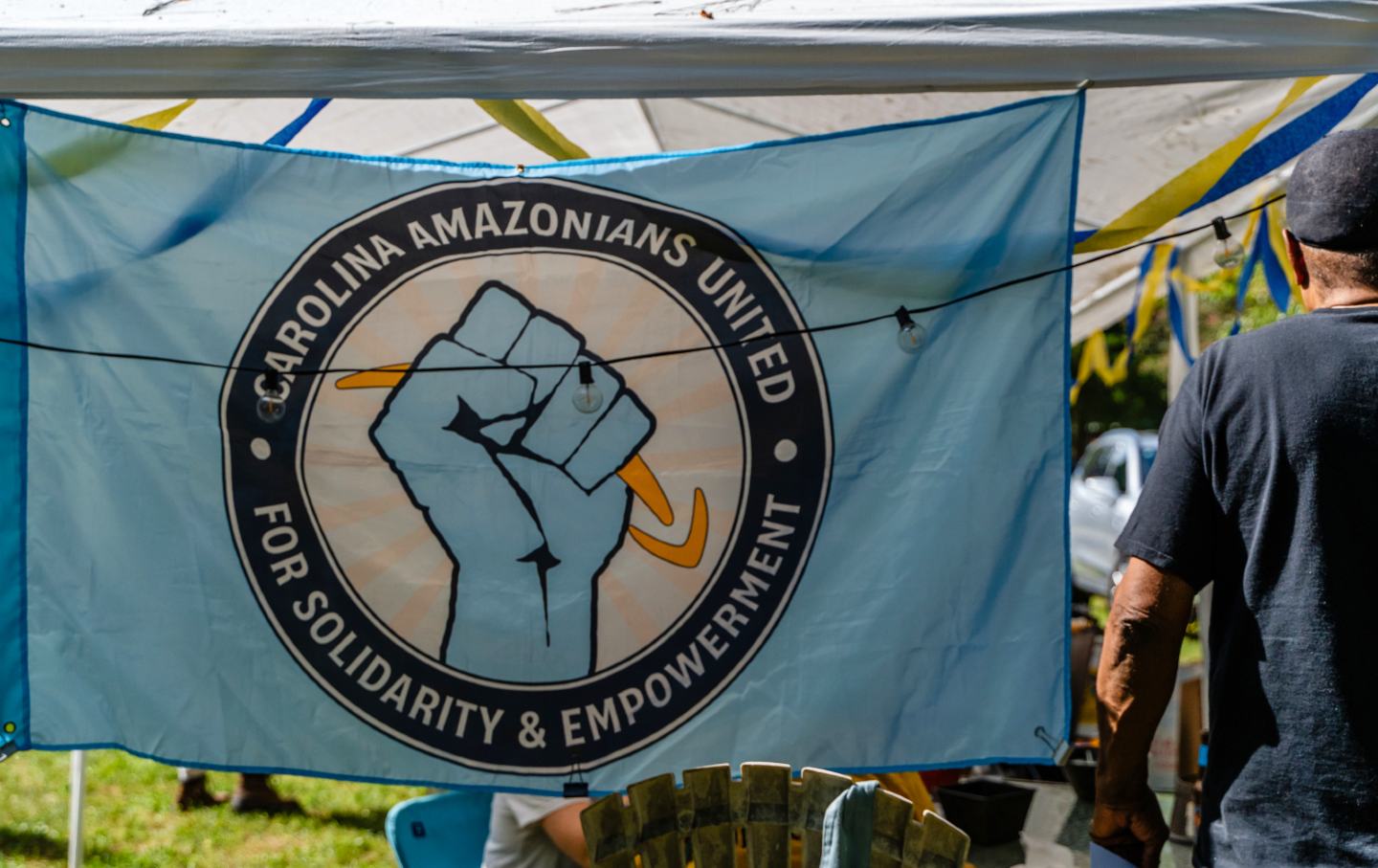
Amazon managers, however, seemed to mischaracterize how unions function to sway workers. In an audio recording shared with me of a small-group “voluntary informational session,” an operations manager implies that workers who choose not to pay union dues will not receive union benefits. (North Carolina is a right-to-work state, so workers can opt out of paying union dues.) “If I choose not to pay, and you pay, and we both have a problem, and we go to talk to somebody, [is CAUSE] going to take care of me if I don’t choose to pay into it?” he says. “[If] I’m not attending the meetings because I’m not a dues-paying member, how do you take care of me?”
Amazon seemed to repeat the claim that workers who do not pay dues may not receive union benefits on flyers posted in and around bathrooms (dubbed “inSTALLments” by the company). The poster reads, “Who will CAUSE really care about? CAUSE represents its paying members. We care about giving every individual a voice.”
According to Celine McNicholas, director of policy at the Economic Policy Institute, the idea that the union would provide benefits only to dues-paying members is false. “It is essentially the opposite situation in right-to-work states,” she wrote to me in an e-mail. “Non-dues paying members still receive the benefit of union representation without paying for the representation.”
As workers cast their votes, organizers hope their message will cut through the constant thrum of anti-union rhetoric. “I’m watching three years of work and holding my breath,” said Dulberg. Amazon organizers from across the country have traveled to North Carolina to support CAUSE, including Teamsters organizers, workers at Amazon’s Kentucky air hub, and Chris Smalls, the founder of the first official union of Amazon warehouse workers in Staten Island. “People are really looking at us to be able to win this thing and use that momentum to get a contract,” said Medelius. “Not just a contract for us, but for everybody that is waiting for a contract from Amazon right now.”

